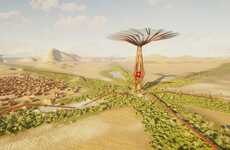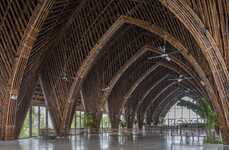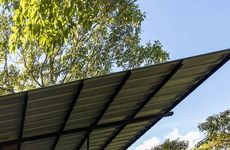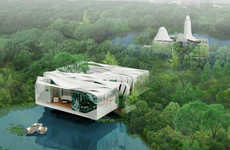
Amos Chapple Photographs the Wettest Place on Earth
Alyson Wyers — September 6, 2014 — World
References: theatlantic & designtaxi
In this stunning photography series for Atlantic Magazine, Amos Chapple captures a village in Meghalaya, India known as the 'wettest place on Earth.' Located in the steep Khasi Hills, Mawsynram receives 467 inches of rain every year due to summer air currents passing over Bangladesh's floodplains.
The unceasing precipitation results in unique imagery as villagers and labor workers are forced to wear protective gear like woven bamboo and banana leaf umbrella hats (called knups). The uncommonly fertile terrain also lends itself to natural architectural innovations like living bridges as well, which are made out of rubber tree roots and last longer than man-made structures.
Amos Chapple is no stranger to documenting fascinating communities, having previous experience shooting daily life in Iran and the Tunnel of Love in Ukraine.
The unceasing precipitation results in unique imagery as villagers and labor workers are forced to wear protective gear like woven bamboo and banana leaf umbrella hats (called knups). The uncommonly fertile terrain also lends itself to natural architectural innovations like living bridges as well, which are made out of rubber tree roots and last longer than man-made structures.
Amos Chapple is no stranger to documenting fascinating communities, having previous experience shooting daily life in Iran and the Tunnel of Love in Ukraine.
Trend Themes
1. Protective Gear Innovation - Capturing the use of woven bamboo and banana leaf umbrella hats in response to excessive rainfall could spark innovation in sustainable rain gear.
2. Natural Architecture Advancements - Documenting living bridges made from rubber tree roots and other natural materials could inspire investments in sustainable infrastructure and construction projects.
3. Extreme Weather Tourism - Highlighting destinations with unique weather patterns, such as the 'wettest place on Earth,' could expand the scope of weather-based tourism experiences.
Industry Implications
1. Apparel - Exploring new materials and designs for rain gear can disrupt the apparel industry with eco-friendly and cost-effective alternatives.
2. Architecture and Engineering - Researching and investing in natural construction methods can disrupt the traditional construction industry with more sustainable and innovative practices.
3. Travel and Tourism - Promoting extreme weather destinations and unique experiences can disrupt the tourism industry and expand the scope of travel options.
5
Score
Popularity
Activity
Freshness























